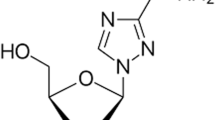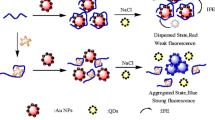Abstract
We describe a novel fluorescent bioprobe for the sensitive and selective detection of double-stranded DNA (dsDNA). It consists of quantum dots (Q-dots) whose fluorescence is quenched (through photoinduced electron transfer) on covering them with the Al(III)-pefloxacin complex. It is found, however, that dsDNA has an affinity for this complex that is so strong that it can break up the binding to the quantum dots, this leading to a complete recovery of the fluorescence of both the Q-dots and the Al(III)-pefloxacin complex. Dual fluorescence (peaking at 420 and 547 nm) is observed under a single excitation wavelength of 350 nm. Neither ribonucleic acid, bovine serum albumin, nor biologically relevant metal ions are capable of giving this effect. The detection limit (3σ/k) for herring sperm DNA is 15.3 μg L−1 if determined via the fluorescence of the Q-dots, and 48 μg L−1 via the Al(III)-pefloxacin complex. The method was applied to the determination of hsDNA in synthetic samples and gave excellent results.

Al3+-pefloxacin mesylate (QDs-Al3+-PFLX) complex acts as an excellent quencher of the fluorescence of QDs, which was attributed to the photoinduced electron transfer from QDs to Al3+-PFLX complex. Due to the strong and specific binding of double-stranded DNA with Al3+-PFLX complex, the fluorescence intensity of QDs-Al3+-PFLX dyads system is restored








Similar content being viewed by others
References
Murphy CJ (2002) Optical sensing with quantum dots. Anal Chem 74:520–526
Gao XH, Yang LL, Petros JA, Marshal FF, Simons JW, Nie SM (2005) In vivo molecular and cellular imaging with quantum dots. Curr Opin Biotechnol 16:63–72
Chidawanyika W, Litwinski C, Antunes E, Nyokong T (2010) Photophysical study of a covalently linked quantum dot-low symmetry phthalocyanine conjugate. J Photochem Photobiol A 212:27–35
Yin YD, Talapin D (2013) The chemistry of functional nanomaterials. Chem Soc Rev 42:2484–2487
Shan YM, Wang LP, Shi YH, Zhang H, Li HM, Liu HZ, Yang B, Li TY, Fang LW (2008) NHS-mediated Q-dots-peptide/protein conjugation and its application for cell labeling. Talanta 75:1008–1014
Wang GL, Jiao HJ, Zhu XY, Dong YM, Li ZJ (2012) Enhanced fluorescence sensing of melamine based on thioglycolic acid-capped CdS quantum dots. Talanta 93:398–403
Ye C, Wang YQ, Li CG, Yu J, Hu YZ (2013) Preparation of liposomes loaded with quantum dots, fluorescence resonance energy transfer studies, and near-infrared in-vivo imaging of mouse tissue. Microchim Acta 180:117–125
Chao MR, Hu CW, Chen JL (2014) Fluorescent turn-on detection of cysteine using a molecularly imprinted polyacrylate linked to allylthiol-capped CdTe quantum dots. Microchim Acta. doi:10.1007/s00604-014-1209-6
Han SQ, Wang JB, Jia SZ (2014) Determination of formaldehyde based on the enhancement of the chemiluminescence produced by CdTe quantum dots and hydrogen peroxide. Microchim Acta 181:147–153
Rödiger S, Liebsch C, Schmidt C, Lehmann W, Genger UR, Schedler U, Schierack P (2014) Nucleic acid detection based on the use of microbeads: a review. Microchim Acta. doi:10.1007/s00604-014-1243-4
Wei W, Zhang DM, Li HN, Yin LH, Pu YP, Liu SQ (2014) Label-free and rapid colorimetric detection of DNA damage based on self-assembly of a hemin-graphene nanocomposite. Microchim Acta. doi:10.1007/s00604-014-1245-2
Liang WJ, Liu ZQ, Liu SP, Yang JD, He YQ (2014) A novel surface modification strategy of CdTe/CdS Q-dots and its application for sensitive detection of ct-DNA. Sensors Actuators B 196:336–344
Feng CL, Zhong HX, Steinhart M, Caminade AM, Majoral JP, Knoll W (2008) Functional quantum-dot/dendrimer nanotubes for sensitive detection of DNA hybridization. Small 4:566–571
Liu X, Freeman R, Golub E, Willner I (2011) Chemiluminescence and chemiluminescence resonance energy transfer (CRET) aptamer sensors using catalytic hemin/G-quadruplexes. ACS Nano 5:7648–7655
Gill R, Willner I, Shweky I, Banin U (2005) Fluorescence resonance energy transfer in CdSe/ZnS − DNA conjugates: probing hybridization and DNA cleavage. J Phys Chem B 109:23715–23719
Wang LR, Qu N, Guo LH (2008) Electrochemical displacement method for the investigation of the binding interaction of polycyclic organic compounds with DNA. Anal Chem 80:3910–3914
Wang SF, Peng TZ, Yang CF (2003) Investigation on the interaction of DNA and actinomycin D by cyclic voltammetry. J Electroanal Chem 554:87–92
Nowicka AM, Zabost E, Donten M, Mazerska Z, Stojek Z (2007) Electroanalytical and spectroscopic procedures for examination of interactions between double stranded DNA and intercalating drugs. Anal Bioanal Chem 389:1931–1940
Ross DL, Riley CM (1990) Aqueous solubilities of some variously substituted quinolone antimicrobials. Int J Pharm 63:237–250
Shen LL, Pernat AG (1985) Mechanism of inhibition of DNA gyrase by analogues of nalidixic acid: the target of the drugs is DNA. Proc Natl Acad Sci 82:307–311, NAS
Yildiz I, Tomasulo M, Raymo FM (2006) A mechanism to signal receptor-substrate interactions with luminescent quantum dots. NAS 103:11457–11460
Zhao D, Chan WH, He ZK, Qiu T (2009) Quantum dot-ruthenium complex dyads: recognition of double-strand DNA through dual-color fluorescence detection. Anal Chem 81:3537–3543
Liu YF, Yu JS (2009) Selective synthesis of CdTe and high luminescence CdTe/CdS quantum dots: the effect of ligands. J Colloid Interface Sci 333:690–698
Yu WW, Qu LH, Guo WZ, Peng XG (2003) Experimental determination of the extinction coefficient of CdTe, CdSe, and CdS nanocrystals. Chem Mater 15:2854–2860
Crosby GA, Demas JN (1971) The measurement of photoluminescence quantum yields. J Phys Chem 75:991–1024
Sandros MG, Benson DEGD (2005) A modular nanoparticle-based system for reagentless small molecule biosensing. J Am Chem Soc 127:12198–12199
Peng H, Zhang LJ, Kjällman THM, Soeller C, Travas-Sejdic J (2007) DNA hybridization detection with blue luminescent quantum dots and dye-labeled single-stranded DNA. J Am Chem Soc 129:3048–3049
Cai ZX, Chen GX (2011) Huang X, Ma MH (2011) determination of lysozyme at the nanogram level in chicken egg white using resonance rayleigh-scattering method with Cd-doped ZnSe quantum dots as probe. Sensors Actuators B 157:368–373
Peng JJ, Liu SP, Wang L, Liu ZW, He YQ (2009) Study on the interaction between CdSe quantum dots and chitosan by scattering spectra. J Colloid Interface Sci 338:578–583
Liu SP, Kong L (2003) Interaction between isopoly-tungstic acid and berberine hydrochloride by resonance rayleigh scattering spectrum. Anal Sci 19:1055–1060
Fu SH, Liu ZF, Liu SP, Yi AE (2008) Study on the resonance Rayleigh scattering, second-order scattering and frequency doubling scattering spectra of the interactions of palladium(II)-ceftriaxone chelate with anionic surfactants and their analytical applications. Talanta 75:528–535
Skoog DA, Holler FJ, Nieman TA (1998) Principles of instrumental analysis, 7th edn. Saunders College, Philadelphia, pp 601–608
Wang GL, Dong YM, Yang HX, Li ZJ (2011) Ultrasensitive cysteine sensing using citrate-capped CdS quantum dots. Talanta 83:943–947
Lakowica JR (1999) Principles of fluorescence spectroscopy, 2nd edn. Plenum Press, New York, p 237
Chen GZ, Huang XZ, Xu JG, Zheng ZZ, Wang ZB (1990) The methods of fluorescence analysis, 2nd edn. Beijing Science Press, Beijing, p 2
Lakowicz JR (2006) Principles of fluorescence spectroscopy, 3rd edn. Springer Science Business Media, New York
Chen W (2008) Nanoparticle fluorescence based technology for biological applications. J Nanosci Nanotechnol 8:1019–1051
Liang JG, Huang S, Zeng D, He Z, Ji X, Ai X, Yang H (2006) CdSe quantum dots as luminescent probes for spironolactone determination. Talanta 69:126–130
Brus LE (1984) Electron–electron and electron–hole interactions in small semiconductor crystallites: the size dependence of the lowest excited electronic state. J Chem Phys 80:4403–4409
Klimov VI (2000) Optical nonlinearities and ultrafast carrier dynamics in semiconductor nanocrystals. J Phys Chem B 104:6112–6123
Khac SB, Moreau NJ (1994) Interactions between fluoroquinolones, Mg2+, DNA and DNA gyrase, studied by phase partitioning in an aqueous two-phase system and by affinity chromatography. J Chromatogr A 668:241–247
Reece RJ, Maxwell A (1991) DNA gyrase: structure and function. Crit Rev Biochem Mol Biol 26:335–375
Zhao LL, Wu X, Ding HH, Yang JH (2008) Fluorescence enhancement effect of morin-nucleic acid-L-cysteine-capped nano-ZnS system and the determination of nucleic acid. Analyst 133:896–902
He Y, Yan XP (2011) Mn-doped ZnS quantum dots/methyl violet nanohybrids for room temperature phosphorescence sensing of DNA. Sci Ch Chem 54:1254–1259
Liu ZQ, Liu SP, Wang XD, Li PP, He YQ (2013) A novel quantum dots-based OFF-ON fluorescent biosensor for highly selective and sensitive detection of double-strand DNA. Sensors Actuators B 176:1147–1153
Huang CZ, Li YF, Tong SY (1997) Spectrofluorimetric determination of niicleic acids with aluminum (III)/8-hydroxyquinoline complex. Anal Lett 30:1305–1319
Li WW, Xu JG, Guo XQ, Zhu QZ, Zhao YB (1997) A novel fluorometric method for DNA and RNA determination. Anal Lett 30:527–536
Huang FH, Chen GN (2008) Preparation and application ofl-cysteine-modified CdSe/CdS core/shell nanocrystals as a novel fluorescence probe for detection of nucleic acid. Spectrosc Acta Part A 70:318–323
Wei M, Guo L, Famouri P (2011) DNA biosensors based on metallo-intercalator probes and electrocatalytic amplification. Microchim Acta 172:247–260
Acknowledgments
This work was supported by Chongqing Municipal Key Laboratory on Luminescence and Real-Time Analysis, Southwest University (CSTC, 2006CA8006) and the National Natural Science Foundation of China (No. 20875078).
Author information
Authors and Affiliations
Corresponding author
Electronic supplementary material
Below is the link to the electronic supplementary material.
ESM 1
(PDF 270 kb)
Rights and permissions
About this article
Cite this article
Liang, W., Liu, Z., Li, D. et al. Quantum dots modified with the Al(III)-pefloxacin complex as a novel bioprobe for the sensitive turn-on and dual-fluorescence detection of dsDNA. Microchim Acta 182, 297–306 (2015). https://doi.org/10.1007/s00604-014-1332-4
Received:
Accepted:
Published:
Issue Date:
DOI: https://doi.org/10.1007/s00604-014-1332-4




